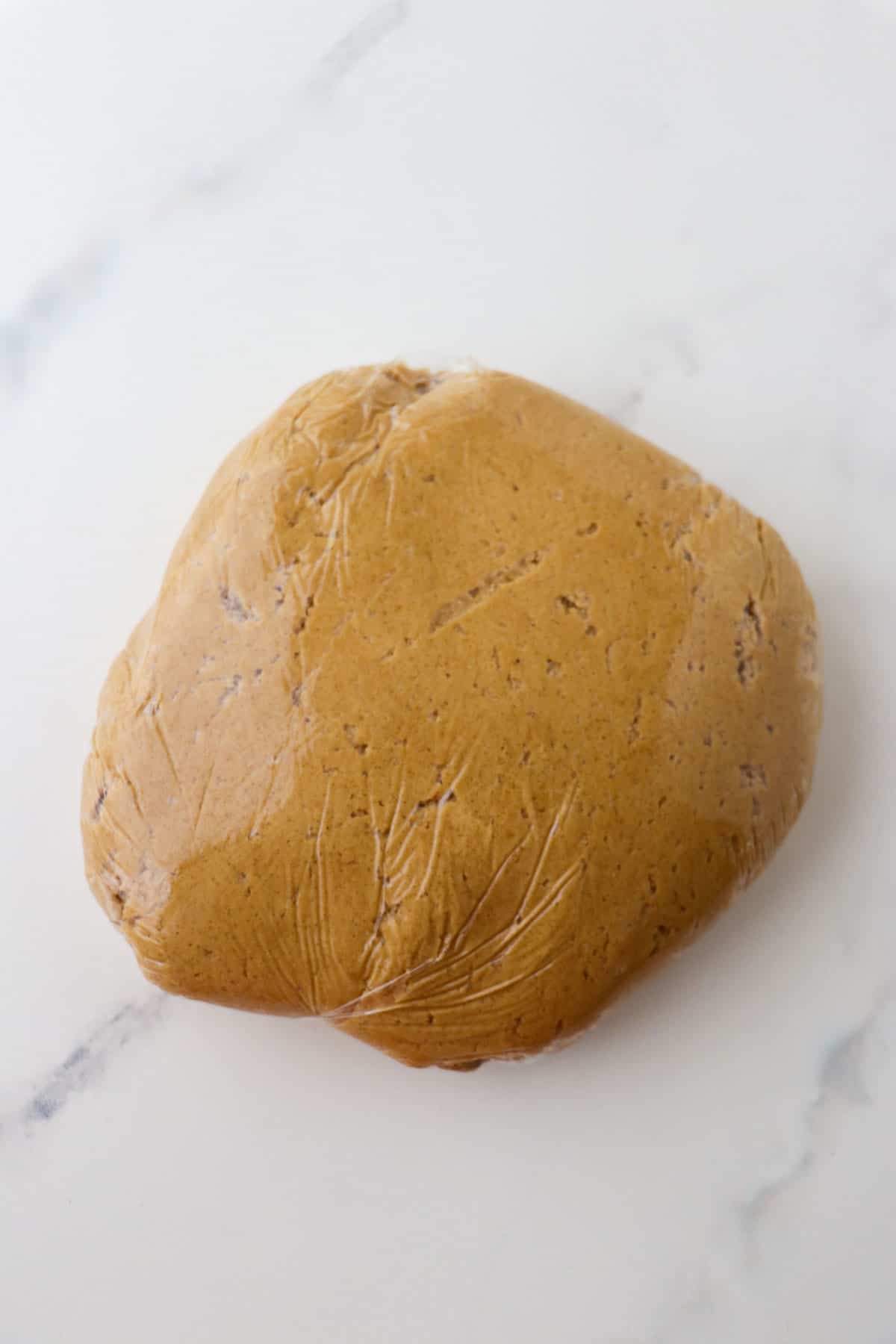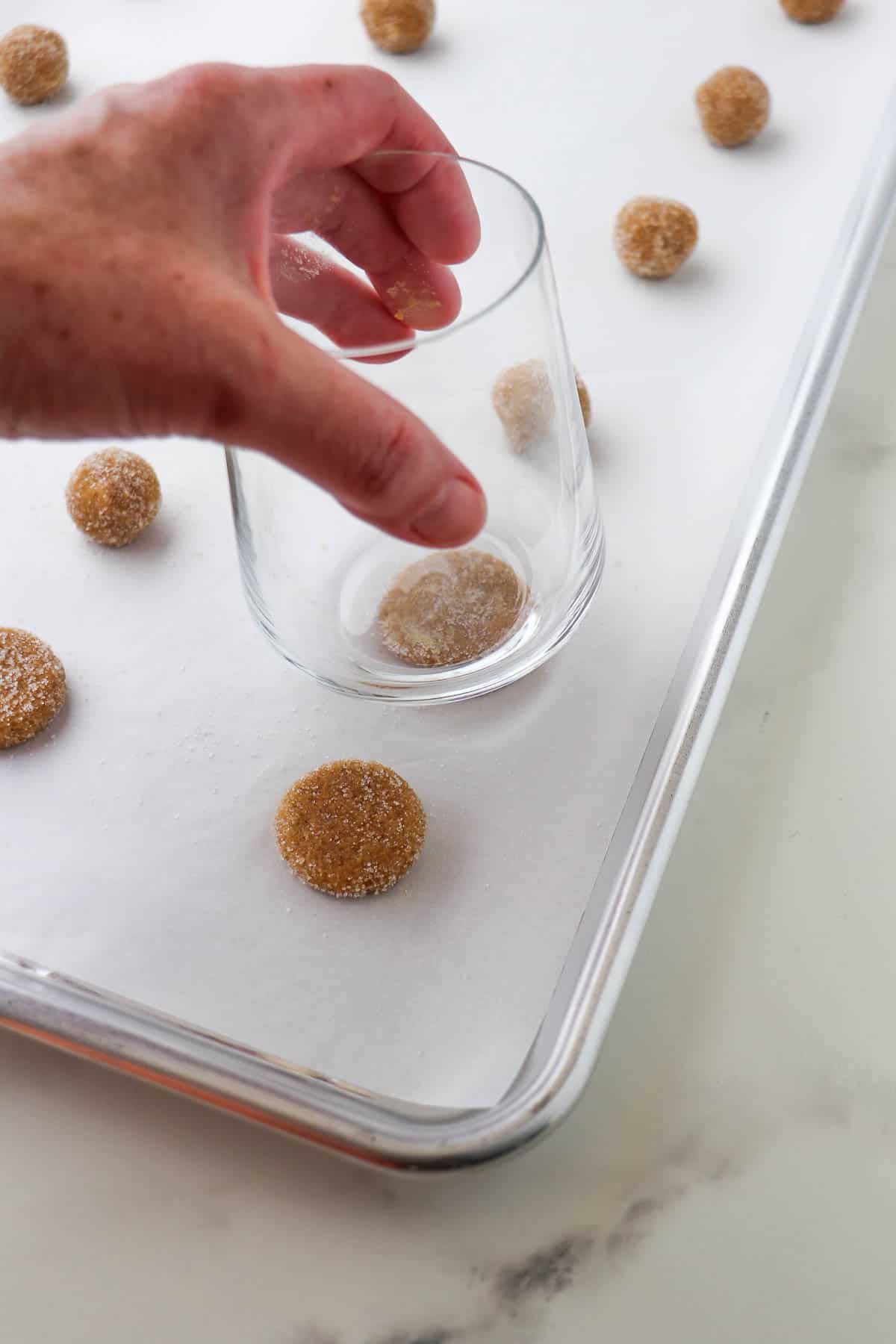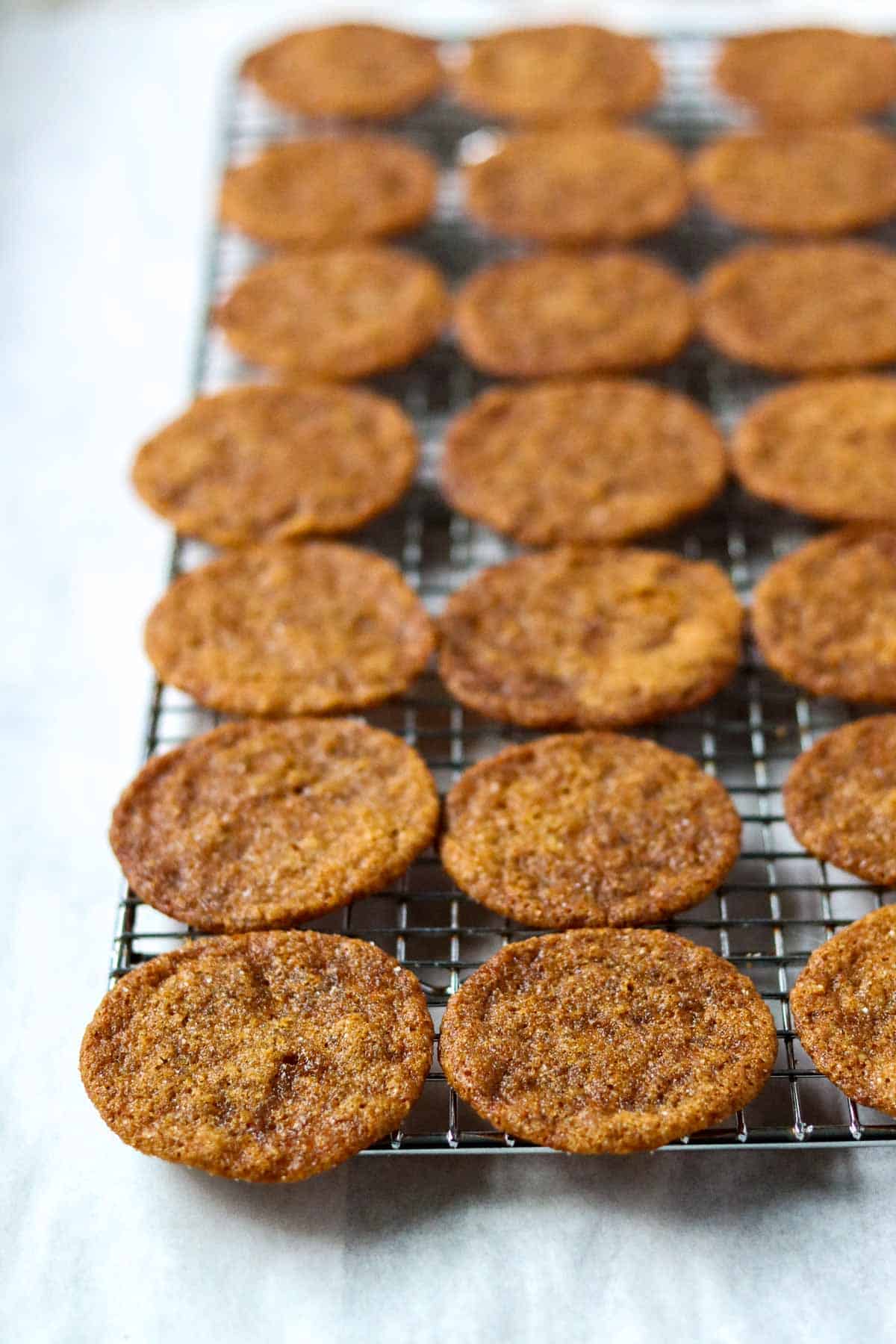These Swedish Ginger Cookies (Pepparkakor in Swedish) are REALLY something special...thin, melt-in-your-mouth buttery and with just the right amount of warm spices. This is a cookie recipe I guarantee you will want to turn to again and again!
Slightly chewy on the inside and crisp around the edges, the texture of these Swedish Ginger Cookies is unique and somewhat addictive. The recipe comes from my Swedish great grandmother and has a long, delicious history in our family. And now I'm here to share this keeper with YOU along with all of the tips, tricks and step-by-step instructions you need to make perfect pepparkakor every time.

Why This Recipe Works
- The unique crisp/chewy texture of these Swedish Ginger Cookies is partially thanks to the inclusion of pastry flour in the dough. While pastry flour is not something you might normally stock in your pantry, these cookies are reason enough to pick some up (or see the FAQs below for an easy substitution).
- They are super thin and bursting with cozy warm spice flavor.
- These cookies are EASY and fun to make!
Ingredients

- Pastry flour. As I mentioned above, this ingredient gives these cookies their unique texture and thin appearance. For a substitute for pastry flour you can use 1 ¾ cup all purpose flour mixed with ¼ cup cornstarch. The cookies will not be as thin using this substitute but they will be tender and delicious!
- Molasses and sugar provide sweetness.
- Baking soda is our leavener, and cinnamon, ginger and cloves provide warm spice flavor.
- Butter brings richness to the dough and an egg adds a bit of structure.
See the recipe card below for specific amounts and instructions for making this recipe.
How to Make This Recipe
- Whisk the dry ingredients together in a bowl and set aside.
- Combine the butter, sugar and molasses in the bowl of a stand mixer. Mix on medium speed until the mixture is light and fluffy, about 3 minutes. Add the egg and mix until fully combined.


- Add the dry ingredients to the butter mixture and mix on low until the dough just comes together. Transfer the dough t a piece of plastic wrap and wrap tightly. Refrigerator for at least 2 hours or freeze for 20-30 minutes.


- Preheat the oven to 350 degrees and line a baking sheet with parchment paper. Place ½ cup of sugar in a small bowl nearby and find a drinking glass with a flat bottom.
- Remove the dough from the refrigerator or freezer. Tear off one small piece at a time. Roll the dough between your palms into a small ball about ¾ inch in diameter. Place the dough ball in the bowl of sugar and roll it around until it is completely coated. Place the dough ball of the prepared baking sheet.
- Continue with the remaining dough until the baking sheet is filled, leaving at least 1 inch of space between each dough ball on the baking sheet (the cookies will spread considerably). Dip the bottom of the drinking glass in the bowl of sugar and press down on each ball flattening it into a disk shape that is about ¼ inch thick. Dip the bottom of the glass back into the bowl of sugar each time you flatten a cookie.


- Place the baking sheet in the oven and bake for 8-10 minutes or until the cookies are just set. Do not over bake. Let them cool completely on the baking sheet before transferring to a wire rack. Repeat with the remaining dough, re-chilling the dough as necessary to make it easier to work with (the dough will be stickier as it warms up).

Expert Tips
- Use pastry flour. The texture of these cookies when made with pastry flour is sublime. It is well worth the investment.
- Chill the dough thoroughly and keep it cold as you roll the cookies. Because pastry flour is so soft, this dough can be sticky and a bit difficult to work with. Make sure your dough is good and cold before you begin rolling it. I like to take just a portion of it from the fridge for rolling, leaving the rest in the refrigerator until I need it. If you find that the dough is becoming too soft to work with, put it back into the fridge or freezer and let if firm up before working with it again.
- Roll small balls of dough, no more than ¾ inch in diameter and leave plenty of room between cookies. These cookies spread as they bake and if you don't start with a small portion of dough, the ginger snaps will run together as they bake. I am usually able to get 5 rows of 4 cookies on each sheet.
- Dip the bottom of your glass in sugar before flattening each cookie. As I said, this dough is sticky and if you don't have a protective layer of sugar on the bottom of your glass, it will stick to the unbaked cookie. Also, that outer layer of sugar helps contribute to the delightful texture of the finished product.
- Don't over bake. The cookies will rise slightly in the oven and then fall becoming flat. This is when they are done. In my oven that takes about 8 minutes per batch.
- Cool the cookies completely before removing them from the pan. This helps them release cleanly without any sticking. If you try to remove them too soon, the pepparkakor have a tendency to stick to the parchment paper.
FAQs
After baking and cooling the cookies completely, simply store at room temperature in an air tight container for up to 3 days. For longer storage, see the FAQ about freezing below.
Yes! These cookies freeze really well. Be sure they have completely cooled before placing them in a tightly sealed freezer-safe container or freezer bag. They will keep for at least 3 months in the freezer. You can also freeze the dough if you prefer!
Pastry flour is a very soft, low-protein flour that produces exceptionally tender baked goods (pastry flour has approximately 9 percent protein while all-purpose flour has closer to 11 percent).
A combination of all-purpose flour and cornstarch is a common substitute for pastry flour. For this recipe you will need 1 ¾ cup all-purpose flour and ¼ cup cornstarch in place of the 2 cups of pastry flour. Swedish Ginger Cookies made with this pastry flour substitute will indeed be soft and tender, but they will not have that thin, crispy-chewy quality of the original. They are still delicious, but they will be slightly thicker and have a more chewy texture throughout than the pastry flour version.
"Peppar" means pepper and "kakor" means cookie or biscuit (it can also mean cake which can be a little confusing). While there is no pepper in this (and most) recipes for pepperkakor, it generally refers to the warm spices (think cinnamon, ginger, cloves) present in the dry ingredients.
Pepparkakor are uniquely thin but vary in texture from crisp and crunchy to slightly chewy depending on the recipe. Some ginger cookies are simply flattened disks (like this one) while others are meant to be rolled out and cut into shapes prior to baking. The cookies are often eaten plain but can be decorated with icing or glaze for a touch of extra sweetness and a little decoration. They are an excellent accompaniment to coffee tea or glögg (Swedish mulled red wine)!
Related Recipes
Looking for more classic Swedish cookies to bake at home? Give these a try!
I really hope you try these Swedish Ginger Cookies. They are truly one of a kind. Please let me know if you do in the comments below!
Recipe

Swedish Ginger Cookies (Pepparkakor)
Ingredients
For the Dough:
- 2 cups pastry flour OR 1 ¾ cups all-purpose flour and ¼ cup cornstarch
- 1 ½ teaspoons baking soda
- ½ teaspoon salt
- ½ teaspoon ground ginger
- ½ teaspoon ground cinnamon
- ¼ teaspoon ground cloves
- ¾ cup butter
- ¾ cup sugar
- ¼ cup molasses
- 1 egg
To Roll Out the Cookies:
- ½ cup granulated sugar more if needed
Instructions
- Whisk pastry flour (or all-purpose flour and cornstarch), baking soda, salt, ginger, cinnamon and cloves together in a medium bowl. Set aside.
- Combine butter, sugar and molasses in the bowl of a stand mixer. Mix on medium speed until mixture is light and fluffy, about 3 minutes. This will take longer if you are mixing by hand. Reduce speed to low and add the egg. Mix until fully combined.
- Add flour mixture to butter mixture. Mix on low speed until just combined. Using a spatula, transfer dough to a large piece of plastic wrap. Wrap tightly and place in the refrigerator for at least 2 hours or up to one day or, alternatively, place dough in the freezer for 20 to 30 minutes. The dough will be easier to work with if it is well-chilled.
- Preheat oven to 350 degrees and line a baking sheet with parchment paper. Place ½ cup of sugar in a small bowl and find a drinking glass with a flat bottom.
- Remove a portion of the dough from the refrigerator. Tearing off one small piece at a time, roll dough between your palms into a small ball about ¾ inch in diameter. Dough will be sticky. Place dough ball in the bowl of sugar and roll it around until it is completely coated. Place ball on prepared baking sheet.
- Continue with remaining dough until baking sheet is filled, leaving at least 1 inch of space between each dough ball on the baking sheet. Dip the bottom of the drinking glass into the bowl of sugar and press down on each ball flattening it into a disc approximately ¼ inch thick. Be sure to dip the glass in the sugar before flattening each cookie.
- Place baking sheet in the oven and bake cookies for 8-10 minutes or until cookies are just set. Do not over bake if you want the center of the cooke to remain slightly chewy. Let cool completely on the baking sheet before transferring to a wire rack. Repeat with remaining dough, rechilling the dough as necessary if it becomes difficult to work with.
Video
Nutrition
If you loved this recipe, give it a star review! Also, snap a picture of your Swedish Ginger Cookies (Pepparkakor) and share it with me on Instagram using the hashtag #truenorthkitchen and tagging me @true_north_kitchen.










Laura Terrazas says
So yummy! I added a touch of flaky sea salt on top and extra ginger.. These are so good!
Martina says
Super yummy cookies. Not a Swedish cookie, but still very nice.
Kristen Morley says
These are amazing and super easy! I was a little nervous that I got in over my head when I saw the recipe said "makes 80-90" but it goes really fast especially since they only take about 8 mins 🙂 I made a batch for christmas and have already made another batch the other day! The texture is incredible- crispy, but not too hard, and they're buttery and melt in your mouth...perfect amount of spice as well...thank u so much, this recipe is definitely a new favorite!
Benjamin Reif says
Was butter in the original recipe or was lard? I ask because a lot of older recipes use lard instead of butter
Kristi says
By the time the cookie recipe got to me it called for butter.
Allison says
Can you help me troubleshoot? Mine didn’t melt down. I even specifically bought pastry flour. I’m bummed because the look soo nice, I really want to try again but I’d like to change whatever I did that made them not shrink down enough.
Kristi says
So they are taller than you expected? Not as thin? Did you press them down with a glass? Another possibility is that the flour was packed down in the measuring cup so that you ended up having more than what is called for. These are the two things that come to mind first! Hope this helps!
Kristi
Debi says
This recipe looks great. I don’t eat cane sugar and was wondering if I could substitute local honey instead.
Kristi says
Hi Debi,
I think that you definitely could use honey but you might need to add a little extra flour as I'm thinking the dough will otherwise be more wet and sticky because of the extra liquid from the honey. Hope this helps!
Kristi
Lena says
These were outrageously delicious! I don’t equate these to ginger snaps since they are much thinner and delicate. Perfect with coffee or tea, as a gift or to take to a party! if you show up with these to a BBQ etc, you will be a rockstar.
I absolutely do think the pasty flour made the difference. Because I had seen another recipe that also included cardamom I added a 1/2 tsp, and I also increased the recipe by 1/2 so I could freeze some of the dough.
I believe it was because my kitchen was quite warm and it’s humid outside that the glass press didn’t work and kept sticking , and I was working quickly! I ended up using wax paper over the dough balls and voila it worked like a charm. I just had to peel it off carefully, almost horizontally. I also shaved off time in between batches, about 1-2mins to avoid overbaking. Thanks again for this easy but delicious recipe!
Kristi says
Thanks, Lena! Now I want to make a batch. Yum! 🙂
Kristi
Ryan says
Very tasty. I made another version recently that called for browned butter which was close to this one. My cookies took awhile to bake, with convection and a small cookie scoop, I had to bake a few minutes longer for a chewy cookie. There wasn't a crisp on mine. I used AP flour and cornstarch. Still, they tasted very good. My other version called for fresh grated ginger and browned butter which I think tasted a little better than this simpler version. Not sure if the flour is why I couldn't get a crisp even at 13 minutes @350 convection .